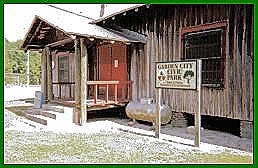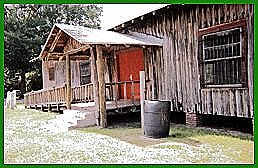 |
 |
| During the English Occupation of Florida, at the time
of the Revolutionary War, north of Trout River there were a
few sawmills and isolated farms raising mostly cotton, tobacco, and indigo.
These were mostly abandoned when
England gave Florida back to Spain.
During the War Between the States there were a number of skirmishes in the area. One such, on July 13, 1864, took place on the north bank of Trout River near what the records of the times describe as the "Turner Place." This would be on what is now Lem Turner Road just east of present day Capper Road. Other skirmises took place when Union forces went north to Callahan in Nassau County, Florida using trails which roughly followed present day Lem Turner Road. | ||
|
The Turner family had settled in the northside area during the late 1700's. Lemuel Turner was born in the old family homestead just east of Capper Road; and, during the early part of this century, he started a shingle mill in the Dinsmore area and a ferry on what was then called Trout Creek although I don't know why. The tributary of the St. John's is a wide expansive river, not at all the little narrow thing most of us think of as a creek. The ferry was known as Turner's Ferry. | |
|
Lem Turner then built a road to that ferry which was called Turner's Ferry Road. In 1913, the Garden City Realty, then owned by William Clarke and T. Frazier Bowie, were hired to map out the area for Dunn Avenue and Lem Turner roads to be paved where they are now. At that time from West Court to Duval Road were known as Pinehurst and from across and to North Court was called Blakehurst. Lem Turner Road was relocated and part of Pinehurst is now Lem Turner Road. The Roads were paved and in 1929 turned over to the county. | ||
|
Paving the roads brought more people to the area. Many of them were loggers because, after years of burning off the land to support livestock, there were beautiful strands of yellow pine, also known as slash pine or longleaf pine. "Ok, technically there is a difference between these three types of pine; but, on a practical level, as concerns their appearance and uses, not; and, they do seem to interbreed!" | |
This type of pine thrives on land that has been recently burnt. In fact, the seed will not even germinate until it has been exposed to fire. In this way, the seedling will have a good chance of getting plenty of sunlight instead of having to try to survive in the shade of older and bigger trees. | ||
|
Slash Pines are very useful for lumber and turpentine among other things. Since even before the Civil War, and especially after, they have been a big part of the Southern economy. Scarlet O'Hara's good Georgia pine is also our good Florida pine! Another important timber resource in this area has been live oak. Live oaks are so named because they do not lose their leaves in winter. They grow to be massive trees with branches that reach out so far that the tree is often wider than it is tall! Before the Civil War, the Spanish, English, and American governments reserved all live oak for shipbuilding. They even hired inspectors to keep people from cutting any live oak for private purposes. Still much was cut and used for local shipbuilding. |
|
Live oak or pine, the loggers would cut the logs and take them to be rafted, that is tied on a raft, at a place like Hall's Branch, Blockhouse Creek, Cedar Creek, and Trout Creek that would take the logs to the St. John's River to be floated to mills in Jacksonville. Local people were hired to help with the rafting. It took man and beast, generally oxen and mules, to get these logs to the river. After they were rafted, some of the men rode the logs with the tide. With long poles they would stop the raft from going aground; and, they would keep going as long as the tide was high enough to float the raft. Then they would tie the raft to a nearby tree and wait for the next high tide. |
|
While waiting for the next high tide, they would have their meals. They carried a washtub full of dirt on the raft to hold lightwood to cook their fatback and whatever fish they could catch. This type of logging stopped at about
1900; Most of us long time Garden City folk think of the corner of Lem Turner Road and Dunn Avenue as the "center" of Garden City. Once upon a time, it was uptown - in a way! George Smith built the first grocery store on the northwest corner of Lem Turner Road and Dunn Avenue. This was the first place to sell gasoline in the area. The store was sold to C. C. McAllister Sr.
C.C. McAllister Jr. came to Florida to help his father and moved the store to the northeast corner of Lem Turner Road and Dunn Avenue. It still stands as Harold's Meat Market.
The first barber shop was operated by Robert Parnell who build his shop next to his home on the northeast corner of Lem Turner Road and Dunn Avenue. Most people in Garden City, who have been here any time, remember Carl Richardson as our barber. He build his first shop near his home on Duval Road about a block from Dunn Avenue; but, he later moved it to Lem Turner near Dunn Avenue. It is that little shop, about the size of a birdhouse, that I remember. My father used to go there; and, he would take me there. That I was a girl made no difference. Back then we all went to barbers. There were no such things as beauticians. At least here there wasn't! They say that for a time there was a
confection stand at the southeast corner of Lem Turner Road and
Dunn Avenue; and, a "streetcar" which served
hamburgers; but, I don't remember any of that. What I
remember is the service station build by Ernest Richardson after
the death of Mr. Carnell who had owned the confection stand and
the "streetcar." A "L'il Champ" is there
now and they have Texaco gas. A Community Hall was build on Lem Turner Road with W.P.A. money and materials donated by land owners and loggers. The construction was supervised by the Rev. Tom Coon who was a carpenter as well as the paster of the Garden City Methodist Church. The Community Hall stood for many years as one of Garden City's most enduring landmarks. In the photos below the Hall looks rather run down; but, in reality it is was built of logs and had a very rustic appearance which was quite appealing. The Community Hall was torn down in this
year of 2002. |
 Community Hall front 1999 |
 Community Hall back 1999 |
| Click here to see picture inside
Hall. This page is long enough. So on to page two! home site index |